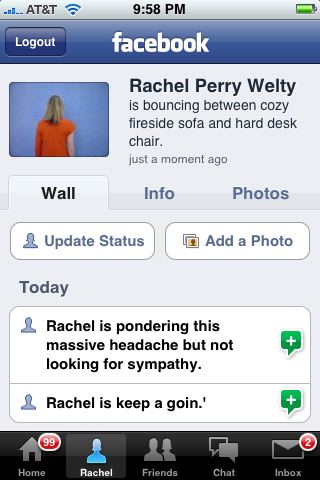
Screenshot from "Rachel is" (Facebook status via iPhone), performed March 11, 2009. Online performance documented by a 551-photograph slideshow of mobile update screen captures from an iPhone. 27 minutes 55 seconds set to loop continuously.
Appropriately enough, I first met conceptual artist Rachel Perry Welty via social media, when word spread about her Facebook-based performance, “Rachel is.” On March 11, 2009, from 7:35 a.m. to 10:56 p.m., she performed using the increasingly popular social network. Every sixty seconds during waking hours she attempted to faithfully answer the status question at the time, “What are you doing right now?” (since replaced by “What’s on your mind?”). We eventually met in person at Status Update, an exhibition at Yale/Haskins Laboratories curated by Debbie Hesse and Donna Ruff that explored the work of artists looking at emerging social media technologies.
Rachel uses a variety of media in her work—sculpture, video, performance, drawing, and installation—mixing minimal aesthetics with Pop humor and homespun craft to create works that point to the mundane and poetic aspects of our everyday lives. Her obsession with mapping the remnants of her daily rituals extends to fruit stickers and bread tags, twist ties and take-out containers, wrong number messages and computer spam. The world of Facebook, quickly becoming a mundane aspect of daily life in the 21st century, presents a logical next step for her explorations.
As so much of my work of late has been with the @Platea social media art collective, I was fascinated with Rachel’s project. I sat down with her via email and chatted a bit about her performance and where she sees social media and art going today.
An Xiao: How long have you been using online social media? How do you use Facebook, Twitter, and other media in your daily life?
Rachel Perry Welty: I’ve been using Facebook and Twitter for less than a year. The New York Times magazine had an in-depth piece about these social networking sites in early September 2008, and this, combined with friends requesting that I join, prompted me to investigate. I’ve found Facebook to be useful as a view to the global artist community, but I don’t send gifts or answer quizzes or throw sheep at people. And I don’t update my status on Facebook anymore after my performance on March 11.
Twitter feels very different to me from Facebook. For one thing, tweets don’t beg for a response. I don’t always want to have a discussion, as much as I just want to report. I have decided to use Twitter as a sort of Amish diary, you know, “Today I plowed the West field and gave birth to a baby boy” sort of thing. Every action is equal. No one experience gets more or less emphasis. I am driven by the limited word count to compose carefully to get as much information in as I can while keeping the poetry alive. All the better when I can do that and twoosh.
I use Twitter as an extension of my creative process, in the sense that it’s a view into the daily life of a working artist. As an artist, my project is concerned with the minutiae of life. As humans, we spend most of our time engaged in the small moments (whether we tweet or Facebook about them or not) and in my project I am trying to get people to notice the things they wouldn’t ordinarily. In that sense, Twitter seems like a perfect platform for me. It’s an ongoing performance.
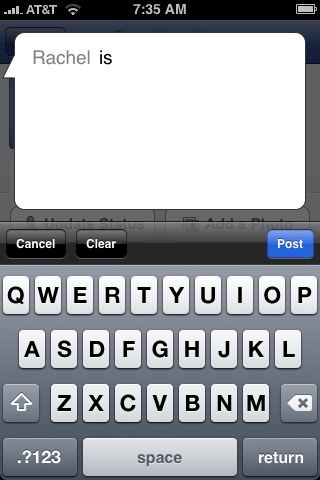
Screenshot from "Rachel is" (Facebook status via iPhone), performed March 11, 2009. Online performance documented by a 551-photograph slideshow of mobile update screen captures from an iPhone. 27 minutes 55 seconds set to loop continuously.
AX: Rachel is was performed shortly before Facebook updated to its live-streaming format, which some have called a direct response to Twitter. What prompted you to perform Rachel Is?
RPW: I had been thinking about and observing how we craft a persona online. I started paying attention and reading people’s status updates in learning my way around Facebook. It struck me that some people must spend more time than others choosing their words, just as some people spend more time getting dressed in the morning. Some are clever and entertaining, some vague or opaque, and others utterly banal. Each statement on its own doesn’t say much, but the collective tells a surprisingly sophisticated story, and forms a portrait of sorts. My performance was a way to make a quick and intense self-portrait. Imposing the limitation of 60 seconds was an attempt to make that more real.
I wanted to go beyond, “Why would I care?” which seems to be a popular response to the status update, and look at the cumulative effect. This is also how I make a drawing: one little sliver of fruit sticker goes down on the paper and another follows, and so on.
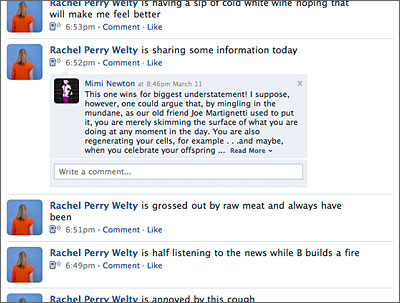
Screenshot from "Rachel is" (Facebook status via iPhone), performed March 11, 2009. Online performance documented by a 551-photograph slideshow of mobile update screen captures from an iPhone. 27 minutes 55 seconds set to loop continuously.
I deliberately performed “Rachel is” knowing that Facebook was planning to change the status bar question from, “What are you doing right now?” to something more vague. My interest was in faithfully and literally answering that question every minute of one day. I was compelled to do the performance because time was running out. In fact, the morning after my performance I sat down at the computer to find a wholly new interface had come into being overnight.
AX: And now there’s a new interface all together, a mix of a live feed and a feed of computer-picked updates. Responses to these changes have always been mixed. What was the response to Rachel is? Were people annoyed, interested? Any surprises?
RPW: I was very much aware that my day in 60-second increments is not particularly interesting. So I truly believed I would be working solo as we artists mostly do. I was doing it for many reasons, but mostly just to see what would happen. This is what propels me to make art.
A few aspects of the experience surprised me: the hundreds of friend requests (from Beijing, Toronto, London, Switzerland, and New York to California) as word of my performance went viral; the level of engagement of others through the comments and messaging function in Facebook, and how little I felt I accomplished in that day.
The community became vital to my progress. It was an endurance project, a marathon, and those comments sustained me. Time actually seemed to disappear as I intensely focused on the task at hand. I developed a routine which involved typing the update, posting, making screen captures of each update for documentation, and setting a timer for the next one. This left me little time to do much else throughout the day, but I managed to do some laundry, start work on a drawing, and make soup from scratch for dinner. It was exhausting being “on” for 16 hours.
Afterwards, I thought of Sophie Calle’s work where she follows a stranger throughout his movements in a day. My work was the reverse: I got strangers to follow me throughout my day. Well, into the next day, I found myself silently narrating (“Rachel is getting a cup of coffee,” “Rachel is ready for a nap”), this experience imprinted on my brain like the afterimage from a flashbulb.
AX: I find I do the same thing now in my day to day life. I often interpret my experiences as status updates, as snippets that I could choose to share with the world. How does Rachel is fit into your larger body of work?
My interests lie in language and the formation of meaning, how we consume, sort, process and sift information, and in the small moments of the everyday. My first body of work used the paper accountings, the remnants from a two-month hospital stay as a beginning. I transcribed by hand my son’s 645-page medical chart onto large gridded sheets of vellum, 23 drawings in total. I was trying to organize the pain of an experience. The words are legible, everything is there, but the quantity of information is so overwhelming that most people will just get bits or phrases and patch together a story.
I also worked with the hospital bill, which was 37 pages long. I created a code of color, a simple substitution cipher. Each letter and number was assigned a color; color became the new language. The bright color, precisely laid, painted a steady and repeated burial of fact. I was focused on the implication of systems where order and control work to overcome chaos and trauma.
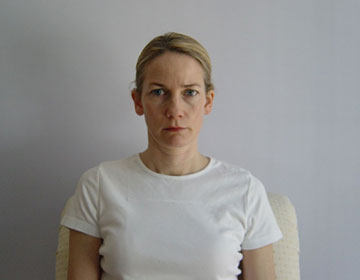
Rachel Perry Welty, "Karaoke Wrong Number," 2004. Production still.
A more recent work, and probably the one I am best known for at this point is the video, Karaoke Wrong Number, in which I saved, transcribed, memorized and then lip-synced the wrong-number messages left in my voicemail inbox over the course of about four years. Identity, information, and privacy are all themes. Collecting the messages isn’t so different from collecting receipts, family medical records, produce stickers, and twist ties. I just see it as digital debris.
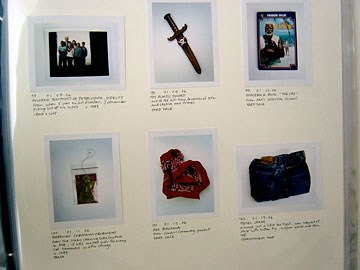
Rachel Perry Welty, "Deaccession Project," October 5, 2005–ongoing. Volumes I through IV. Ink, photographs, archival adhesive, paper, plastic sleeves, albums; each album: 13 x 14.5 x 3 in.
I explore the diaristic in the ongoing Deaccession Project. Much like Rachel is, the aggregate phenomenon creates an unintentional portrait of me. Since October 5, 2005, I have chosen one item each day to purge from my household. I fastidiously document with photographs, giving each item a catalog number and date, name, description, and provenance. The items are then either sold on Craigslist, given to Goodwill, set aside for a yard sale, given to a friend or relative, consigned to a re-sale shop, recycled or trashed. I am the curator of my possessions.
I photograph the objects snapshot-style and paste them up into a traditional scrapbook, which mitigates the “pain” of separating from my belongings; the photo can then prompt the memory and stand in for the object. People always like to know, “What are you giving away today?” Today it’s a mostly-used bottle of supermarket oregano. I was making chili yesterday and I realized it is probably about 10 years old! Ugh. Now I am buying spices in tiny quantities from Penzey’s.
AX: Probably a more sustainable choice! In your statement, you mentioned that you aim “to raise more questions about narcissism, voyeurism, privacy, identity and authority, as issues we consider in a technologically modern world.” What do you see as the role of online social media in society?
RPW: That’s a big question. I’m not sure we know yet. Clearly, it’s a way to communicate with a lot of people quickly and without friction. Relationships will be easier to maintain for a long time, for good or for ill. Imagine, as my son will probably experience, never losing touch with your best friend from 3rd grade. (Michelle Turner from Mr. Brentnall’s class at NIS in Tokyo, are you out there?!) Will it make it impossible to shed your identity as you move through life? Will you always be who you once were?
AX: That’s a great question, and something I see people asking more and more, both online and off. In fact, it seems like there’s something of a zeitgeist going on with online social media and art. New Media Scotland and the Brooklyn Museum both sponsor Twitter art feeds, Matt Held received a ton of attention for his Facebook portrait paintings, you conducted your performance shortly after the Armory shows, and we both participated in Status Update at Yale/Haskins Laboratories, which was covered by The New York Times. Not to mention, of course, that Art21 recently launched this new Art 2.1 column.
RPW: I was only aware of Lee Walton and Matt Held’s work as I began my performance, and now I see that there are many more artists who are working with social media as material. It was sheer coincidence that I received a call-for-entries for the show Status Update from a friend during my performance on March 11. As I was performing, I was also conversing online with one of the curators of the show, Debbie Hesse.
AX: So interesting how conversation and performance intermingle when done online. What do you see as the future of online social media and art?
RPW: It’s simply another tool for the artist’s arsenal; a material like oil paint or clay or a pencil on paper.
Born in 1962, in Tokyo, Japan, Rachel Perry Welty holds a BA from Connecticut College and a Diploma and Fifth Year Certificate from the Museum of Fine Arts Boston. Welty received many awards from the Museum School, including Traveling Scholarships in 2001 and 2004. Recently, Welty participated in group shows at The Drawing Center, New York and at the Institute of Contemporary Art, Boston, Massachusetts, where her video Karaoke Wrong Number has entered the permanent collection. She has had solo shows at Barbara Krakow Gallery (Boston), Yancey Richardson Gallery (New York), and will show her work in a solo exhibition at Gallery Diet (Miami) in 2010.
Artist An Xiao looks at technology and the 21st century using a creative approach that is one part visual/conceptual and one part Zen. Recently listed in The Guardian’s “who’s who” of the Twitter art world, she has shown her award-winning photography and digital media in publications and galleries internationally, including the Brooklyn Museum, Yale/Haskins Laboratories, The New York Times and ARTNews. She founded and directs @Platea, a global online public art collective and tweets at @thatwaszen.




Pingback: Facebook performance – What are you doing right now « Brave new world
Pingback: What’s Cookin at the Art21 Blog: A Weekly Index | Art21 Blog
Pingback: Reflective Space: Feeding into Ourselves « Dialogical Balance
Pingback: The Bell » ‘Rachel Perry Welty: 24/7′
Pingback: Vacation Rentals | Rachel Perry Welty | NJ Art Exhibition | New Jersey